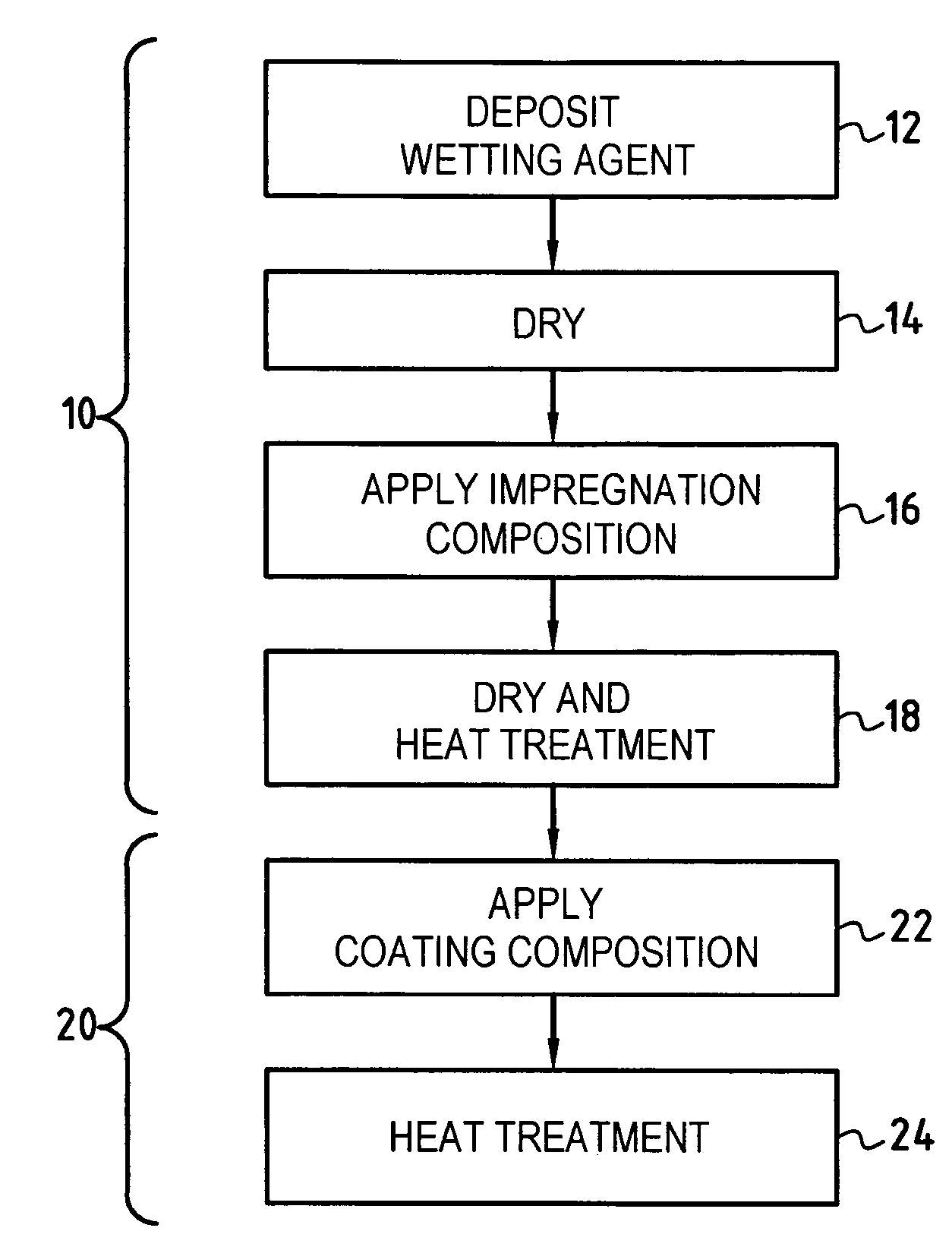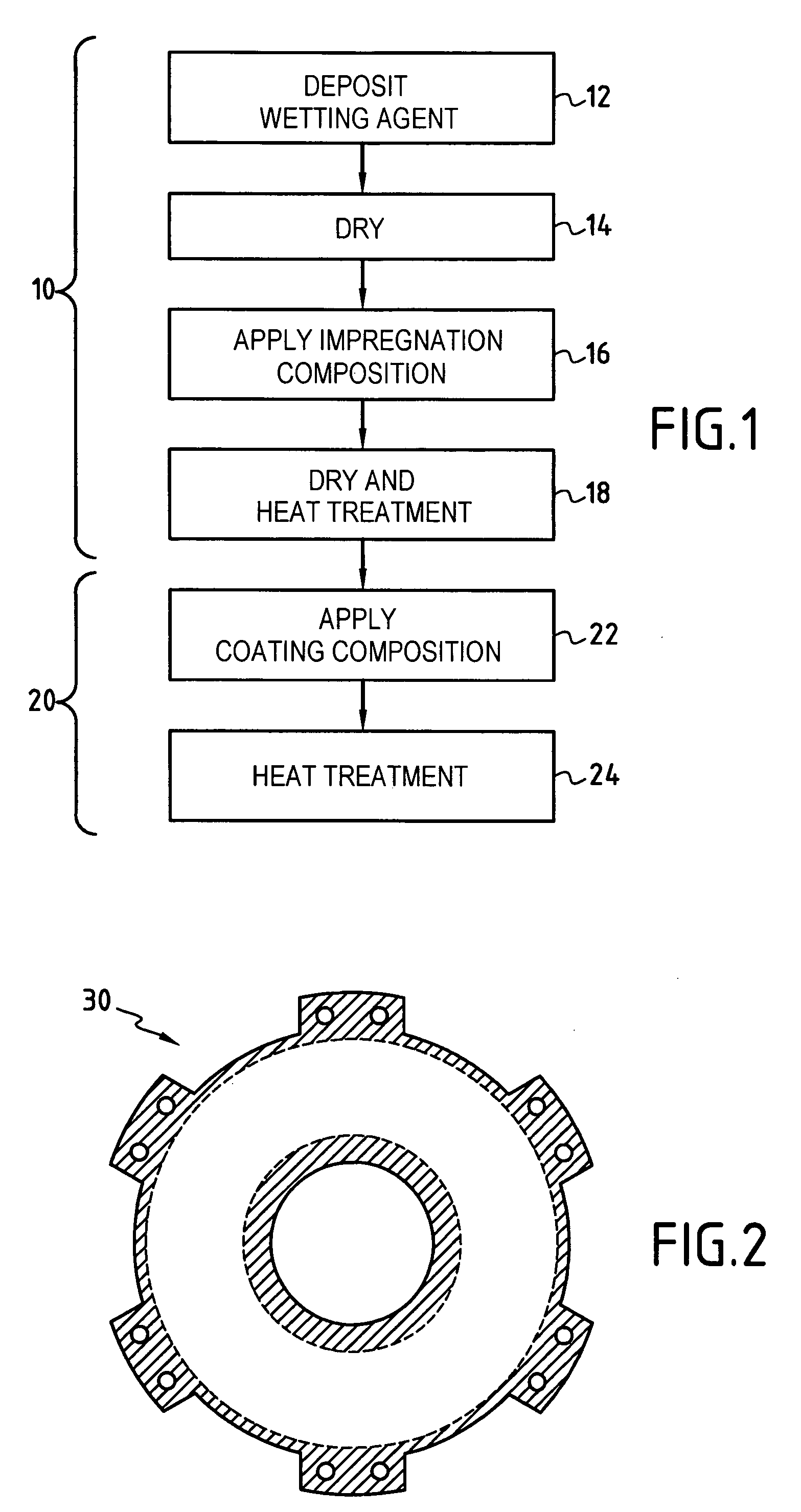Anti-oxidation protection for parts made of carbon-containing composite material
a technology of carbon-containing composite materials and anti-oxidation protection, which is applied in the direction of friction lining, ceramicware, brake discs, etc., can solve the problems of affecting the service life of the coating, affecting the performance of the protective barrier, and affecting the long-term sealing of the sic coating against the surrounding medium
- Summary
- Abstract
- Description
- Claims
- Application Information
AI Technical Summary
Benefits of technology
Problems solved by technology
Method used
Image
Examples
example 1
[0053] Samples of C / C composite material were made in the following manner:
[0054] fiber plies were formed by superposing three unidirectional sheets of carbon fibers making angles of ±60° relative to one another, with the sheets being bonded together by light needling;
[0055] the resulting fiber plies were superposed and the plies were bonded together by needling as they were being superposed so as to obtain a thickness of several centimeters;
[0056] circular preforms were cut out from the fiber plate as obtained in that way; and
[0057] the preforms were densified by a matrix of pyrolytic carbon formed by chemical vapor infiltration so as to obtain a relative density equal to about 1.73.
[0058] The resulting samples were impregnated with an aqueous solution containing 0.5% by weight of a wetting agent (surfactant) sold by the German supplier Hüls under the name “Marlophen 89”. For this purpose, the samples were immersed in a bath of said solution contained in a tank associated with...
example 2
[0089] A sample D of C / C composite material was provided with an external protective layer like the sample C of Example 1, but omitting the phosphate-based internal protection. Table II below shows the results obtained (relative weight losses) with the samples C and D under two oxidation conditions.
TABLE IICDOxidation20(1) mg / cm2—conditions17(2) mg / cm217(2) mg / cm2p-650−0.0540.731p-650 KAc2.056.95
[0090] The results obtained show the very considerable improvement in the protection by associating internal protection and external protection as compared with external protection on its own.
examples 3 , 4
EXAMPLES 3, 4, AND 5
[0091] A sample E was obtained by providing a sample A of Example 1 with external protection obtained by:
[0092] applying an aqueous composition comprising 36.4 parts by weight of “FFB33K” colloidal silica at a concentration of 30%, 4.8 parts of water, 12.2 parts of “Pyrex” glass powder, and 48.6 parts of TiB2 from the supplier Alfa Aesar; and
[0093] heat treatment at 90° C. in air for 2 h.
[0094] A sample F was obtained like sample E except that the heat treatment was performed under nitrogen at 700° C. for 1 h.
[0095] A sample G was obtained like sample E, except that the heat treatment was performed in air at 800° C. for 15 min.
[0096] Table III below shows the results obtained (relative weight losses) after performing an oxidation test on the samples E, F, and G.
TABLE IIIOxidationconditionsEFGp-6500.2641.40.256
[0097] Short heat treatment at 800° C. in air is industrially preferable.
PUM
| Property | Measurement | Unit |
|---|---|---|
| Fraction | aaaaa | aaaaa |
| Fraction | aaaaa | aaaaa |
| Fraction | aaaaa | aaaaa |
Abstract
Description
Claims
Application Information
 Login to View More
Login to View More - R&D
- Intellectual Property
- Life Sciences
- Materials
- Tech Scout
- Unparalleled Data Quality
- Higher Quality Content
- 60% Fewer Hallucinations
Browse by: Latest US Patents, China's latest patents, Technical Efficacy Thesaurus, Application Domain, Technology Topic, Popular Technical Reports.
© 2025 PatSnap. All rights reserved.Legal|Privacy policy|Modern Slavery Act Transparency Statement|Sitemap|About US| Contact US: help@patsnap.com


